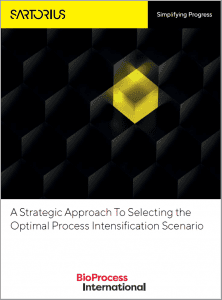- Sponsored Content
- Single Use
A Strategic Approach to Selecting the Optimal Process Intensification Scenario
Sponsored by Sartorius
 Current demands placed on the biopharmaceutical industry are pushing manufacturers toward process intensification, an approach that modifies unit operations or an entire manufacturing process to optimize efficiency. Three common intensification scenarios in upstream processing are seed-train intensification (usually at the n – 1 stage), concentrated fed-batch production, and dynamic perfusion (at the production bioreactor stage). In downstream processes, intensification strategies typically involve moving from single- to multicolumn chromatography. Biomanufacturers can realize several kinds of improvements from intensified processing, including reductions in operation costs, faster production schedules, increased yields, and enhanced flexibility. This special report from writers at Sartorius explores how adopting single-use intensified manufacturing satisfies key business drivers. First, the report provides a process-decision matrix that simplifies the implementation of process intensification in both new and existing facilities. Then, the authors share a case study chronicling the implementation of a single-use production bioreactor populated with high-density cultures of Chinese hamster ovary cells. That intensification strategy facilitated a 30× reduction in inoculation volume, and the resulting cultures and products showed characteristics that were comparable with those that are obtained using standard fed-batch procedures. Read on to learn how biomanufacturers can tackle the equipment-selection process and quickly reap the benefits of process intensification philosophies in their facilities.
Current demands placed on the biopharmaceutical industry are pushing manufacturers toward process intensification, an approach that modifies unit operations or an entire manufacturing process to optimize efficiency. Three common intensification scenarios in upstream processing are seed-train intensification (usually at the n – 1 stage), concentrated fed-batch production, and dynamic perfusion (at the production bioreactor stage). In downstream processes, intensification strategies typically involve moving from single- to multicolumn chromatography. Biomanufacturers can realize several kinds of improvements from intensified processing, including reductions in operation costs, faster production schedules, increased yields, and enhanced flexibility. This special report from writers at Sartorius explores how adopting single-use intensified manufacturing satisfies key business drivers. First, the report provides a process-decision matrix that simplifies the implementation of process intensification in both new and existing facilities. Then, the authors share a case study chronicling the implementation of a single-use production bioreactor populated with high-density cultures of Chinese hamster ovary cells. That intensification strategy facilitated a 30× reduction in inoculation volume, and the resulting cultures and products showed characteristics that were comparable with those that are obtained using standard fed-batch procedures. Read on to learn how biomanufacturers can tackle the equipment-selection process and quickly reap the benefits of process intensification philosophies in their facilities.
Fill out the form below to read the complete report now.
You May Also Like





